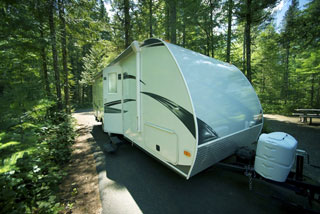Making Wall-Mount Curtains for an RV
Making and sewing wall mounted curtains for an Recreational Vehicle is not very different than sewing curtains for a regular window. The main difference is the method of installation for the RV curtains. Wall mounted curtains for a Recreational Vehicle usually connect to the wall at the top and bottom of the curtain. Curtain Tracks are installed above and below the window. The top and bottom helm of the curtains have a row of Carriers that slide or pop into the tracks. It is preferred to use a sew in vinyl carrier tape on the outside of the curtain helm and then onto the wall mounted track.
Instructions
Measuring the Window:
- Measure and record the length of the window from the outside edge of the top track to the outside edge of the bottom track. It is not recommended to rely on the size of the window. You are measuring the window and the space surrounding the window frame where the tracks are mounted.
- Measure and record the width of the window from one inch outside the left window edge to one inch outside the right window edge.
- Add 4 1/2” inches to the window length to determine the modified length of the curtain. This measurement is to allow extra fabric seam allowance for the top and bottom helms and for enclosing the sew in carrier tape.
- Multiply the width of the window by two. Divide this measurement by two to determine the width of each panel, because RV curtains generally have two panels that you can open them in the center.
Measuring and Cutting the Fabric:
- Lay the fabric on a table with the back side facing up.
- Using chalk, mark two rectangles measuring the modified length (see step 3 Measuring the window)
- Cut the two rectangles from the fabric. These are the two curtain panels.
Sewing the Curtains:
- Lay one fabric panel horizontally on the table with the back side facing up. Fold the left edge of the fabric over ¼ inch onto the back side of the fabric, and then fold it over ½ inch and pin the helm. Repeat this procedure for the right edge of the fabric and for the other curtain panel.
- Sew the left and right helms using a straight stitch and ½ seam allowance. Repeat for the other panel.
- Lay one panel horizontally on the table with the back side facing up. Fold the bottom edge over ¼ inch. Pin the helm. Repeat for the top edge and for the other panel.
- Sew the top and bottom helms using a ¼ inch seam allowance and a straight stitch. Remove the pins and repeat steps for the other panel.
- Measure and cut two pieces of vinyl carrier tape to the width of the hemmed panel.
- Lay the panel onto the table with the back side facing up. Fold the hemmed top edge over 1 inch against the back side of the fabric. Repeat for the bottom panel edge.
- Insert the vinyl carrier tape with the snaps facing up beneath the fold of the top edge, aligning the bottom edge of the tape with the bottom edge of the helm. Repeat for the hemmed bottom edge of the panel.
- Locate the snap bumps under the folded top curtain edge. Rub the bumps with the chalk to indicate the positioning of each snap. Repeat for the bottom panel edge. Remove the inserted vinyl carrier tape.
- Use a fabric hole punch or an eyelet tool to punch holes on the top of each chalk mark. Place fabric horizontally onto the table with the back side facing up. Fold the top and bottom edge over one inch as in step 5.
- Insert the vinyl carrier tape with the snaps facing up under the folded top edge. Align the snaps with the holes in the fabric. Pin through the fabric, the vinyl tape and the lower most layer of fabric. Repeat for the bottom panel edge.
- Insert a machine needle intended for sewing vinyl. Sew the top edge using a straight stitch and a one inch seam allowance. Verify you are sewing through the bottom edge of the vinyl tape to secure the tape within the fabric fold. Remove the pins and repeat for the bottom panel edge.
- Repeat steps 6 thru 11 for the second curtain panel.
Inserting the Carriers:
1. Lay the finished panels with the back side facing up.
- Snap the Carriers to the exposed snaps along the top and bottom edges of the panels.
- Insert or snap the Carriers into the Tracks along the top and bottom of the RV window. Some Tracks require an End Cap to be snapped or screwed to the ends of each track to secure the carriers. Arrange as desired.
Congratulations, you have now successively made your own custom RV curtains.




